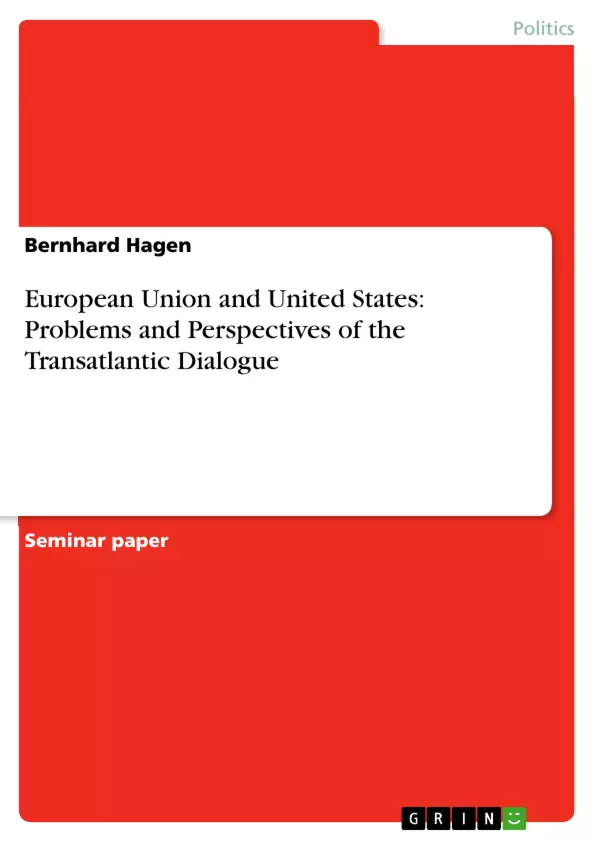The recent developments in the Middle East, particularly the American war with Iraq and the European lack of unity, led to a deterioration of U.S. relations with the European Union. It is the goal of this term paper to explain the historic aspect of the transatlantic dialogue in general and discuss the recent developments.
The paper is split up into three parts. At first, it tries to give an historical overview about the transatlantic relations from 1948 to 1990. The second part discusses the changes in the nineties and the most important documents in the dialogue between the U.S. and the EU. The third and concluding part analyses the status quo of transatlantic relations and explains the reasons of the “new crisis”.
Inhaltsverzeichnis (Table of Contents)
- I. Historical Development
- II. The Nineties: Foundation of a close Dialogue
- The Transatlantic Declaration
- The New Transatlantic Agenda
- The Transatlantic Economic Partnership
- III. Status quo: The New Crisis
Zielsetzung und Themenschwerpunkte (Objectives and Key Themes)
This term paper aims to analyze the historical development of the transatlantic dialogue between the United States and the European Union, with a focus on the recent developments. It explores the historical context of the relationship from 1948 to 1990, examines the shifts in the 1990s and the key documents that shaped the dialogue, and analyzes the current state of transatlantic relations, particularly the “new crisis” that emerged in the early 2000s.
- Historical development of the transatlantic dialogue
- Changes in the transatlantic relationship in the 1990s
- Key documents shaping the dialogue between the US and EU
- The “new crisis” in transatlantic relations
- The impact of international conflicts on US-EU relations
Zusammenfassung der Kapitel (Chapter Summaries)
Chapter 1 provides a historical overview of the transatlantic relationship from 1948 to 1990, highlighting the evolution of the dialogue through four distinct periods. This chapter analyzes the asymmetrical nature of the early relationship, marked by US dominance, and explores the tensions that emerged with Charles de Gaulle’s return to power in France. It further discusses the economic and political challenges that shaped the relationship during this period, including the impact of the Common Agricultural Policy and the French withdrawal from NATO.
Chapter 2 focuses on the 1990s, a decade characterized by improved relations between the US and EU. It highlights the significant role of the Transatlantic Declaration in 1990 and the subsequent efforts to strengthen the dialogue, culminating in the New Transatlantic Agenda and the Transatlantic Economic Partnership. This chapter also examines the impact of European integration and the growing economic and political interdependence between the US and EU.
Chapter 3 analyzes the current state of transatlantic relations, focusing on the “new crisis” that emerged in the early 2000s. This chapter examines the impact of US policies in international conflicts, particularly the Iraq War, on the dialogue. It explores the challenges to the transatlantic relationship stemming from differing views on foreign policy, security, and human rights. This chapter also highlights the difficulties within the EU in formulating a unified response to US policies.
Schlüsselwörter (Keywords)
The key terms and concepts explored in this work include: transatlantic dialogue, US-EU relations, historical development, European integration, international conflicts, New Transatlantic Agenda, Transatlantic Economic Partnership, Iraq War, “new crisis”, foreign policy, security, human rights, and European unity.
- Quote paper
- Bernhard Hagen (Author), 2003, European Union and United States: Problems and Perspectives of the Transatlantic Dialogue, Munich, GRIN Verlag, https://www.grin.com/document/75605



